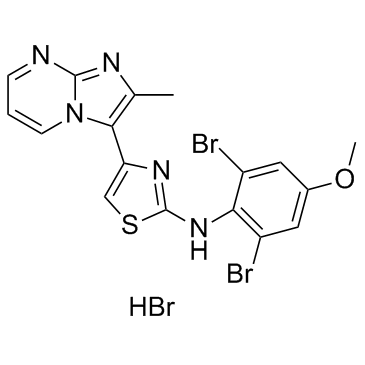| Description |
PTC-209 hydrobromide is a specific BMI-1 inhibitor with IC50 of 0.5 μM in both GEMS reporter and ELISA assays.
|
| Related Catalog |
|
| Target |
IC50: 0.5 μM (BMI-1, in HT1080 tumor cells)[1]
|
| In Vitro |
PTC-209 is a recently developed inhibitor of BMI1, in biliary tract cancer (BTC) cells. PTC-209 reduces overall viability in BTC cell lines in a dose-dependent fashion (0.04-20 μM). Treatment with PTC-209 leads to slightly enhanced caspase activity and stop of cell proliferation. Cell cycle analysis reveals that PTC-209 causes cell cycle arrest at the G1/S checkpoint[2]. PTC-209(100, 200, or 500nM) decreases BMI1 and increases p16 protein expression in canine OSA cell lines. Compare to vehicle control, BMI1 protein expression decreases by 40% and 25% in the Abrams and D17 cell lines, respectively, following 500 nM PTC-209 treatment. In the Moresco cell line, BMI1 protein expression decreases by 16% and 39% following 200nM and 500nM PTC-209 treatment, respectively, as compared to vehicle control. Increases in p16 protein levels could be observed in all cell lines beginning at 100nM PTC-209 and are highest at the 500nM PTC-209 dose for Abrams (120% increase) and Moresco (200% increase), but appeared to top out at 200 nM for the D17 cell line (54% increase)[3].
|
| In Vivo |
Pharmacokinetic analysis demonstrates that PTC-209 (60 mg/kg, subcutaneously once a day) effectively inhibits BMI-1 production in tumor tissue in vivo. Inhibition of BMI-1 with PTC-209 halts growth of preestablished tumors in vivo[1].
|
| Cell Assay |
MTT assays are used to assess proliferation of Abrams, D17, and Moresco canine OSA cells following treatment of PTC-209 alone and in combination with Dox or Carbo. 500 cells are seeded in 96 well plates with DMEM/10%FBS and allowed to adhere overnight (16-18 hrs). For single treatment PTC-209 experiments, cells are incubated with drug for 72hrs at final concentrations of 0, 200, 300, 400, 500, and 600nM. For combination treatment experiments, cells are incubated with drug(s) for 72hrs at the following final concentrations: PTC-209 (0, 100, 200, and 500 nM), Dox (0, 3, and 30 nM), Carbo (0, 3, and 30 μM). Vehicle controls include DMSO (PTC-209), 0.9% saline (Dox), and water (Carbo). Additional controls included untreated (UT) cells (no veh or drug) and wells containing media (DMEM/10%FBS) alone (to assess background absorbance). Briefly, MTT solution is added to each well at a final conc. of 0.5mg/mL and incubated at 37°C for 4hrs. 200uL of DMSO is added to dissolve formazin crystals and absorbance is measured at 570nM and 630nM (reference wavelength) using a spectrophotometer (Spectramax 190). 6 wells per group are used for PTC-209 single treatment experiments, and 4 wells per group are used for combination treatment experiments, and all experiments are repeated twice. Statistical analysis is performed using 2-way ANOVA with Tukey’s multiple comparisons test.
|
| Animal Admin |
Mice[1] For the experiments where mice are dosed with the drug in vivo, tumor cells are injected subcutaneously into nude mice (male, aged 8-10 weeks), and when the tumors reach an approximate 0.2 cm3 volume, PTC-209 is administered subcutaneously once a day at a dose of 60 mg per kg body weight (control animals received equal volumes of vehicle, 14% DMSO, 36% polyethylene glycol 400 and 50% polypropylene glycol). Tumor volume measurements are recorded every 3-7 d until the endpoint is reached.
|
| References |
[1]. Kreso A, et al. Self-renewal as a therapeutic target in human colorectal cancer. Nat Med. 2014 Jan;20(1):29-36. [2]. Christian Mayr, et al. The BMI1 inhibitor PTC-209 is a potential compound to halt cellular growth in biliary tract cancer cells. Oncotarget. 2016 Jan 5; 7(1): 745-758. [3]. Shahi MH, et al. BMI1 is expressed in canine osteosarcoma and contributes to cell growth and chemotherapy resistance. PLoS One. 2015 Jun 25;10(6):e0131006.
|
